wheel CITROEN C4 2019 Owners Manual
[x] Cancel search | Manufacturer: CITROEN, Model Year: 2019, Model line: C4, Model: CITROEN C4 2019Pages: 317, PDF Size: 9.31 MB
Page 3 of 317
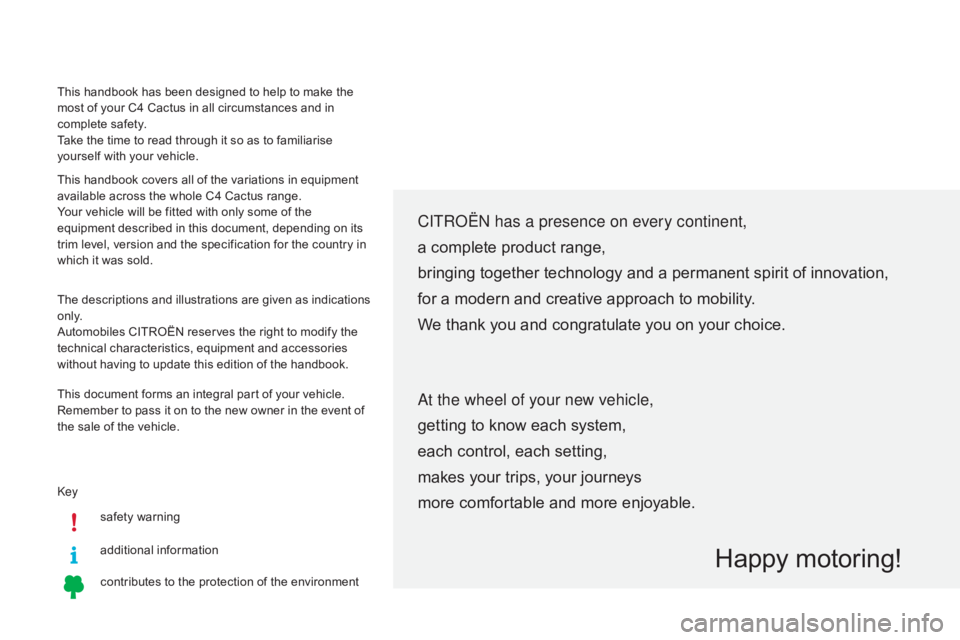
Keysafety warning
additional
in
formation
contributes
to the protection of the environment
CITROËN has a presence on every continent,
a complete product range,
bringing
together technology and a permanent spirit of innovation,
for
a modern and creative approach to mobility.
We
thank you and congratulate you on your choice.
Happy motoring!
At the wheel of your new vehicle,
getting to know each system,
each
control, each setting,
makes
your trips, your journeys
more
comfortable and more enjoyable.
This handbook has been designed to help to make the most of your C4 Cactus in all circumstances and in
c
omplete safety.
Take
the time to read through it so as to familiarise
y
ourself with your vehicle.
This
handbook covers all of the variations in equipment
a
vailable across the whole C4 Cactus range.
Your
vehicle will be fitted with only some of the
e
quipment described in this document, depending on its
t
rim level, version and the specification for the country in
w
hich it was sold.
The
descriptions and illustrations are given as indications
o
n l y.
Automobiles
CITROËN reserves the right to modify the
t
echnical characteristics, equipment and accessories
w
ithout having to update this edition of the handbook.
This
document forms an integral part of your vehicle.
R
emember to pass it on to the new owner in the event of
t
he sale of the vehicle.
Page 4 of 317
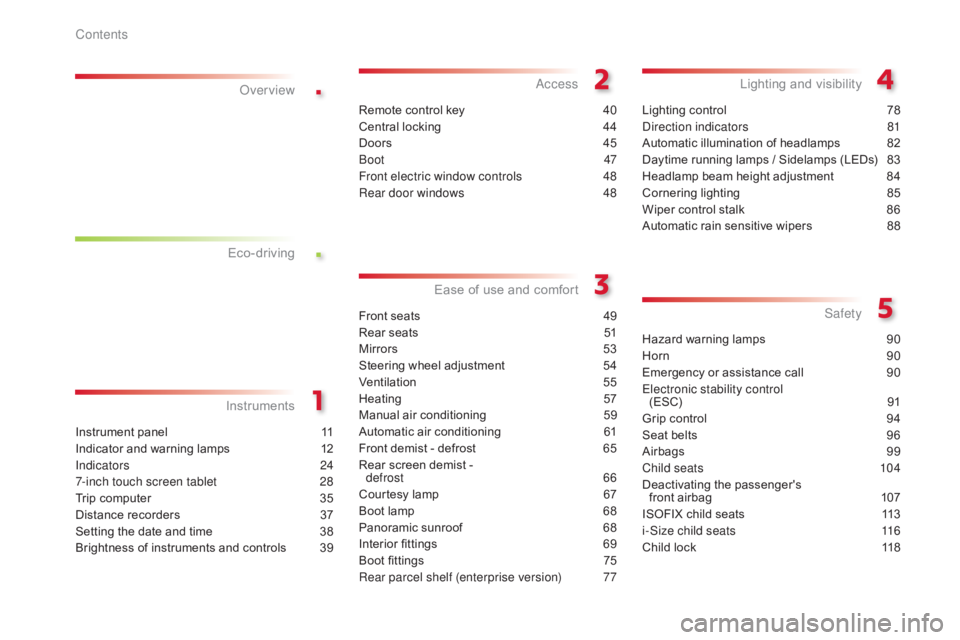
.
.
C4-cactus_en_Chap00a_sommaire_ed01-2016
Instrument panel 11
Indicator and warning lamps
1
2
Indicators
2
4
7-inch touch screen tablet
2
8
Trip
computer
3
5
Distance
recorders
3
7
Setting
the date and time
3
8
Brightness
of instruments and controls
3
9
InstrumentsOver view
Remote control key 4
0
Central locking
4
4
Doors
4
5
Boot
47
Front electric window controls
4
8
Rear door windows
4
8
Access
Front seats 49
Rear seats
5
1
Mirrors
5
3
Steering
wheel adjustment
5
4
Ventilation
5
5
Heating
5
7
Manual
a
ir
c
onditioning
5
9
Automatic
air conditioning
6
1
Front
demist - defrost
6
5
Rear
screen demist -
d
efrost 66
Courtesy
lamp
6
7
Boot
lamp
6
8
Panoramic
sunroof
6
8
Interior
fittings
6
9
Boot
fittings
7
5
Rear parcel shelf (enterprise version)
7
7
Ease of use a nd c omfort
Lighting control 7 8
Direction indicators
8
1
Automatic
illumination of headlamps
8
2
Daytime
running lamps / Sidelamps (LEDs)
8
3
Headlamp
beam height adjustment
8
4
Cornering
lighting
8
5
Wiper
control stalk
8
6
Automatic
rain sensitive wipers
8
8
Lighting and v isibility
Hazard warning lamps 9 0
Horn
9
0
Emergency
or assistance call
9
0
Electronic stability control (ESC)
9
1
Grip
control
9
4
Seat
belts
9
6
Airbags
9
9
Child seats
1
04
Deactivating
t
he
p
assenger's
f
ront airbag
1
07
ISOFIX
child seats
1
13
i-Size child seats
1
16
Child
lock
1
18
Safety
Eco-driving
Contents
Page 5 of 317
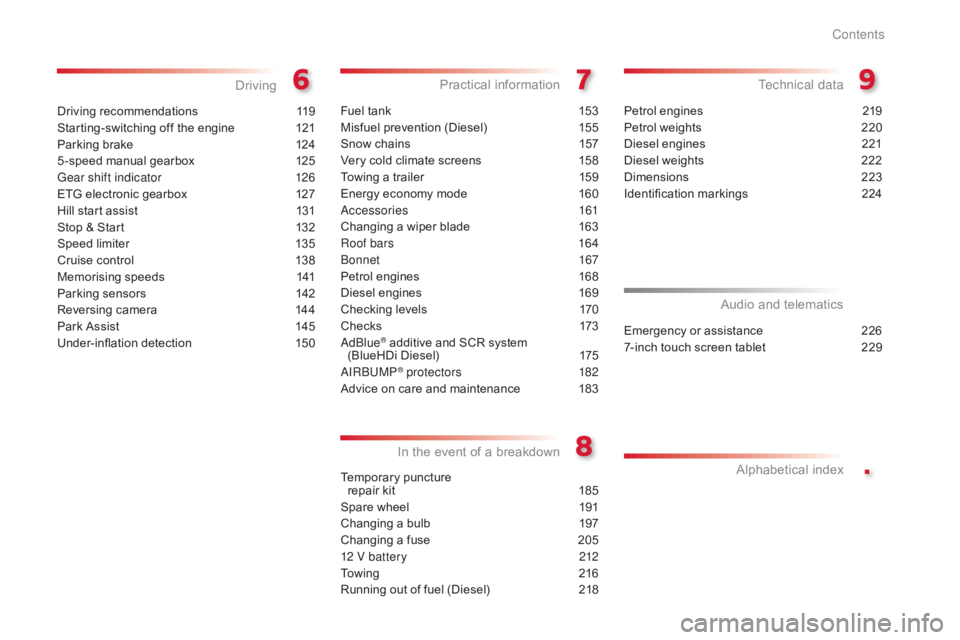
.
C4-cactus_en_Chap00a_sommaire_ed01-2016
Driving recommendations 119
Starting-switching off the engine
1
21
Parking
brake
1
24
5 -speed
manual gearbox
1
25
Gear shift indicator
1
26
ETG
electronic gearbox
1
27
Hill
start assist
1
31
Stop
& Start
1
32
Speed
limiter
1
35
Cruise
control
1
38
Memorising
speeds
1
41
Parking
sensors
1
42
Reversing
camera
1
44
Park
Assist
1
45
Under-inflation
d
etection
1
50
Driving
Fuel tank 1 53
Misfuel prevention (Diesel)
1
55
Snow
chains
1
57
Very
cold climate screens
1
58
Towing
a trailer
1
59
Energy
economy mode
1
60
Accessories
161
Changing
a wiper blade
1
63
Roof bars
1
64
Bonnet
167
Petrol
engines
1
68
Diesel
engines
1
69
Checking
levels
1
70
Checks
1
73
AdBlue
® additive and SCR system
(
BlueHDi Diesel) 1 75
AIRBUMP
® protectors 1 82
Advice
on
care and maintenance
1
83
Practical information
Temporary puncture
r epair kit 1 85
Spare
wheel
1
91
Changing
a bulb
1
97
Changing
a fuse
2
05
12 V battery
2
12
To w i n g
2
16
Running
out of fuel (Diesel)
2
18
In the event o f a b reakdown
Petrol engines 2 19
Petrol weights
2
20
Diesel
engines
2
21
Diesel
weights
2
22
Dimensions
2
23
Identification
ma
rkings
2
24
Technical data
Emergency or assistance 226
7-inch touch screen tablet
2
29
Audio and telematics
Alphabetical
in
dex
Contents
Page 6 of 317
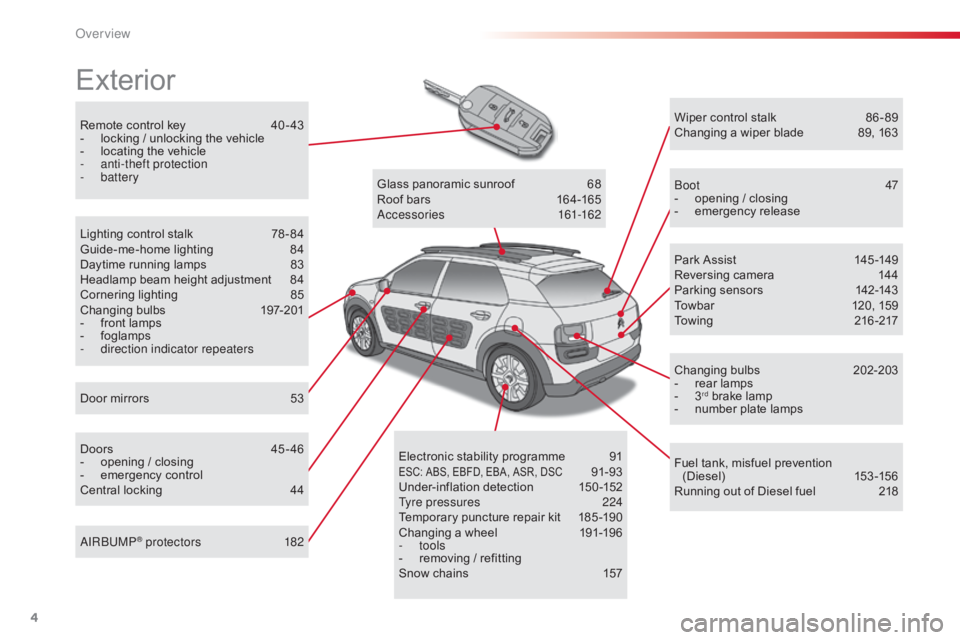
4
C4-cactus_en_Chap00b_vue-ensemble_ed01-2016
Remote control key 40 - 43
- l ocking / unlocking the vehicle
-
l
ocating the vehicle
-
a
nti-theft protection
-
battery
Exterior
Door mirrors 5 3
Lighting control stalk
7
8 - 84
Guide-me-home lighting
8
4
Daytime running lamps
8
3
Headlamp beam height adjustment
8
4
Cornering lighting
8
5
Changing
bu
lbs
1
97-201
-
f
ront lamps
-
fo
glamps
-
d
irection indicator repeaters
Doors
4
5 - 46
-
o
pening / closing
-
em
ergency
c
ontrol
Central
locking
4
4Glass
panoramic sunroof
6
8
Roof bars
1
64-165
Accessories
1
61-162
Wiper control stalk
8
6 - 89
Changing a wiper blade
8
9, 163
Boot
47
-
o
pening / closing
-
em
ergency
r
elease
Park Assist
1
45 -149
Reversing camera
1
44
Parking sensors
1
42-143
Towbar
1
20, 159
Towing
21
6 -217
Changing
bu
lbs
2
02-203
- r ear lamps
- 3rd brake lamp
-
n
umber plate lamps
Fuel
tank, misfuel prevention
(
Diesel)
15
3 -15 6
Running
out of Diesel fuel
2
18
Electronic
s
tability
pro
gramme
9
1
ESC: ABS, EBFD, EBA, ASR, DSC 91-93
Under-inflation d
etection 1 50-152
Tyre pressures
2
24
Temporary
puncture
repair
kit
1
85 -190
Changing
a
wheel
1
91-196
-
tools
-
r
emoving
/
refitting
Snow
chains
1
57
AIRBUMP
® protectors 1
82
Over view
Page 9 of 317
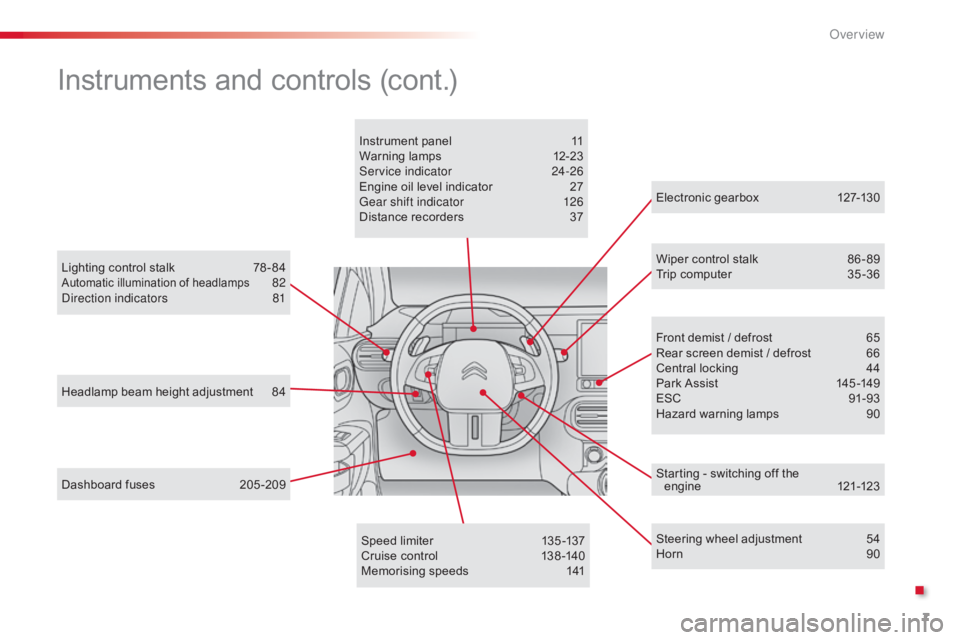
7
C4-cactus_en_Chap00b_vue-ensemble_ed01-2016
Headlamp beam height adjustment 84
Lighting control stalk
7
8 - 84
Automatic illumination of headlamps 82
D
irection indicators 8 1
Dashboard
fuses
2
05 -209 Electronic
gearbox
1
27-130
Wiper control stalk
8
6 - 89
Trip computer 3 5 -36
Speed limiter
1
35 -137
Cruise
control
1
38 -140
Memorising
speeds
1
41Front
demist / defrost
6
5
Rear
screen demist / defrost
6
6
Central
locking
4
4
Park
Assist
1
45 -149
ESC
9
1-93
Hazard
warning lamps
9
0
Instrument
panel
1
1
Warning
lam
ps
1
2-23
Service indicator
2
4-26
Engine oil level indicator
2
7
Gear shift indicator
1
26
Distance recorders
3
7
Steering wheel adjustment
5
4
Horn
9
0
Instruments and controls (cont.)
Starting - switching off the engine 12 1-123
.
Over view
Page 12 of 317
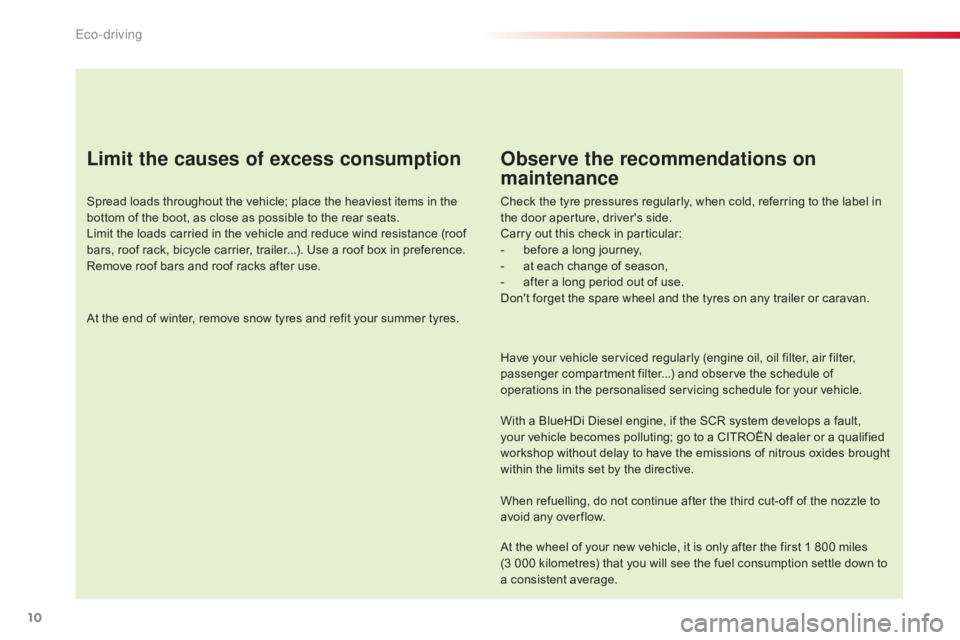
10
C4-cactus_en_Chap00c_eco-conduite_ed01-2016
Limit the causes of excess consumption
Spread loads throughout the vehicle; place the heaviest items in the bottom of the boot, as close as possible to the rear seats.
Limit
the loads carried in the vehicle and reduce wind resistance (roof
b
ars, roof rack, bicycle carrier, trailer...). Use a roof box in preference.
Remove
roof bars and roof racks after use.
At
the end of winter, remove snow tyres and refit your summer tyres.
Observe the recommendations on
maintenance
Check the tyre pressures regularly, when cold, referring to the label in the door aperture, driver's side.
Carry
out this check in particular:
-
b
efore a long journey,
-
a
t each change of season,
-
a
fter a long period out of use.
Don't
forget the spare wheel and the tyres on any trailer or caravan.
Have
your vehicle serviced regularly (engine oil, oil filter, air filter,
p
assenger compartment filter...) and observe the schedule of
o
perations in the personalised servicing schedule for your vehicle.
With
a BlueHDi Diesel engine, if the SCR system develops a fault,
y
our vehicle becomes polluting; go to a CITROËN dealer or a qualified
w
orkshop without delay to have the emissions of nitrous oxides brought
w
ithin the limits set by the directive.
When
refuelling, do not continue after the third cut-off of the nozzle to
a
void any over flow.
At
the wheel of your new vehicle, it is only after the first 1 800 miles
(3
000 kilometres) that you will see the fuel consumption settle down to
a
consistent average.
Eco-driving
Page 25 of 317
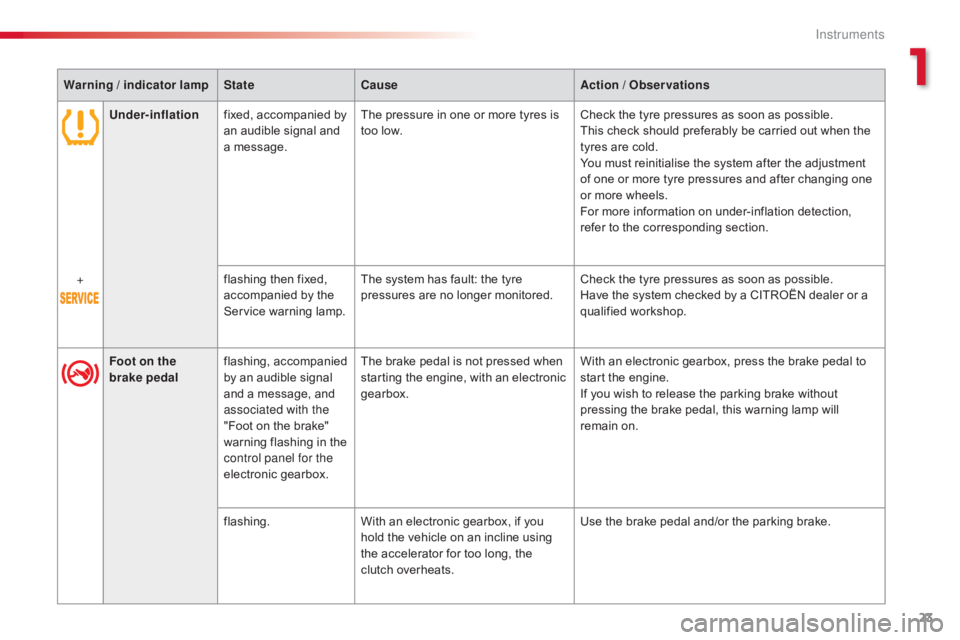
23
C4-cactus_en_Chap01_Instruments-de-bord_ed01-2016
Under-inflationfixed, accompanied by a
n audible signal and
a
message. The
pressure in one or more tyres is t
oo low.Check
the tyre pressures as soon as possible.
This check should preferably be carried out when the
t
yres are cold.
You
must reinitialise the system after the adjustment
o
f one or more tyre pressures and after changing one
o
r more wheels.
For
more information on under-inflation detection,
r
efer to the corresponding section.
+ flashing
then fixed,
a
ccompanied by the
S
ervice warning lamp.The
system has fault: the tyre
p
ressures are no longer monitored.Check
the tyre pressures as soon as possible.
Have
the system checked by a CITROËN dealer or a
q
ualified
w
orkshop.
Foot on the
brake pedal flashing,
a
ccompanied
b
y an audible signal
a
nd a message, and
a
ssociated with the
"Foot
on the brake"
w
arning flashing in the
c
ontrol panel for the
electronic
ge
arbox.The
brake pedal is not pressed when
s
tarting the engine, with an electronic
g
earbox.With
an electronic gearbox, press the brake pedal to
s
tart the engine.
If
you wish to release the parking brake without
p
ressing the brake pedal, this warning lamp will
r
emain on.
flashing. With
an electronic gearbox, if you
h
old the vehicle on an incline using
t
he accelerator for too long, the
c
lutch overheats.Use
the brake pedal and/or the parking brake.
Warning / indicator lamp
StateCause Action / Observations
1
Instruments
Page 52 of 317
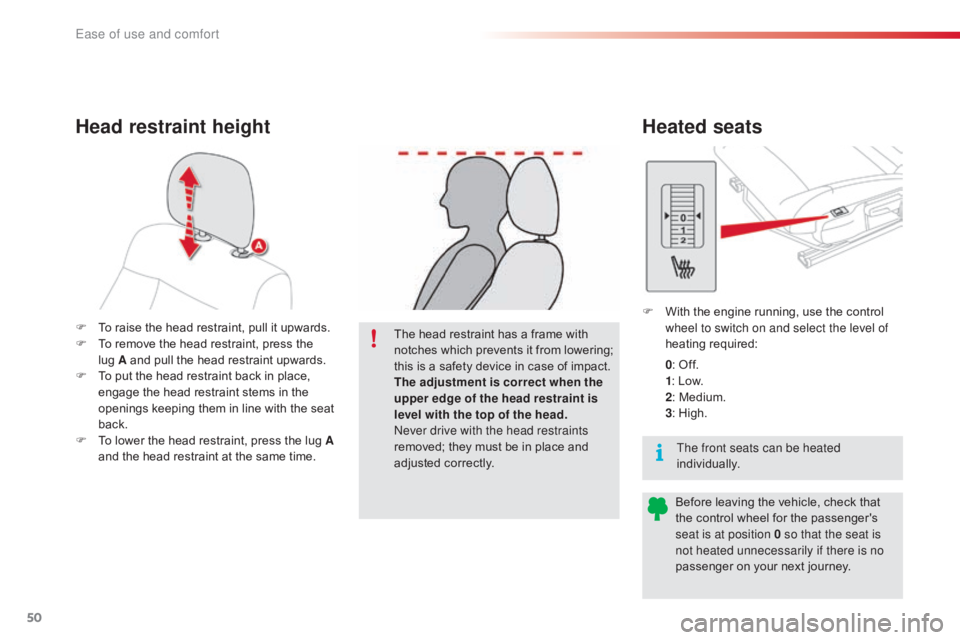
50
C4-cactus_en_Chap03_Ergonomie-et-confort_ed01-2016
F To raise the head restraint, pull it upwards.
F T o remove the head restraint, press the
lug
A and pull the head restraint upwards.
F
T
o put the head restraint back in place,
e
ngage the head restraint stems in the
o
penings keeping them in line with the seat
b
ack.
F
T
o lower the head restraint, press the lug A
and
the head restraint at the same time.The
head restraint has a frame with
n
otches
which
prevents
it
from
lowering;
t
his is a safety device in case of impact.
The adjustment is correct when the
upper edge of the head restraint is
level with the top of the head.
Never drive with the head restraints
removed;
they must be in place and
adj
usted
c
orrectly.
Head restraint heightHeated seats
F With the engine running, use the control w
heel to switch on and select the level of
heating
r
equired:
0 :
Off.
1 :
Low.
2 :
Medium.
3 :
High.
Before
leaving the vehicle, check that
t
he control wheel for the passenger's
s
eat is at position 0 so that the seat is
not heated unnecessarily if there is no
passenger
on your next journey.
The front seats can be heated
individually.
Ease of use and comfort
Page 56 of 317

54
C4-cactus_en_Chap03_Ergonomie-et-confort_ed01-2016
Rear view mirror
Equipped with an anti-dazzle system, which darkens the mirror glass and reduces the
n
uisance to the driver caused by the sun,
headlamps
from other vehicles...
Adjustment
F Adjust the mirror so that the glass is d
irected correctly in the "day" position.
Day / night position
F Pull the lever to change to the "night" anti-
dazzle position.
F
P
ush the lever to change to the normal
"
day" position.
Steering wheel ad justment
F When stationary , lower the control lever A
to release the steering wheel adjustment
m
echanism.
F
A
djust the height of the steering wheel to
s
uit your driving position.
F
Ra
ise the control lever A to lock the
s
teering wheel adjustment mechanism.
As a safety precaution, these
operations should only be carried out
while
the vehicle is stationary.
Correct driving position
Before taking to the road and to make the most of t he e rgonomics o f y our d riving p osition, c arry
o
ut these adjustments in the following order:
-
h
eight of the head restraint,
-
b
ackrest angle,
-
c
ushion height,
-
l
ongitudinal position of the seat,
-
h
eight of the steering wheel,
-
t
he interior and door mirrors.
Once
these adjustments have been made,
e
nsure that from your driving position you
c
an see the instrument panel clearly.
Ease of use and comfort
Page 93 of 317
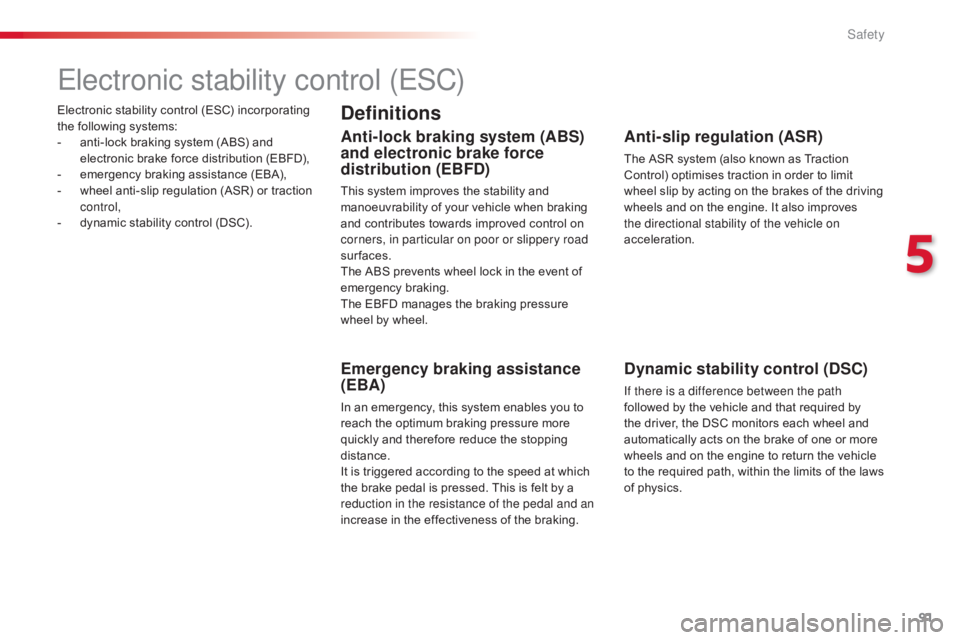
91
C4-cactus_en_Chap05_securite_ed01-2016
Electronic stability control (ESC) incorporating the following systems:
-
a
nti-lock braking system (ABS) and
e
lectronic brake force distribution (EBFD),
-
e
mergency braking assistance (EBA),
-
w
heel anti-slip regulation (ASR) or traction
c
ontrol,
-
d
ynamic stability control (DSC).
Electronic stability control (ESC)
Definitions
Anti-lock braking system (ABS)
and electronic brake force
distribution (EBFD)
This system improves the stability and manoeuvrability of your vehicle when braking
a
nd contributes towards improved control on
c
orners, in particular on poor or slippery road
surfaces.
The
ABS prevents wheel lock in the event of
em
ergency
b
raking.
The
EBFD manages the braking pressure
w
heel by wheel.
Emergency braking assistance
(EBA)
In an emergency, this system enables you to reach the optimum braking pressure more
q
uickly and therefore reduce the stopping
di
stance.
It
is triggered according to the speed at which
t
he brake pedal is pressed. This is felt by a
r
eduction in the resistance of the pedal and an
increase
in the effectiveness of the braking.
Anti-slip regulation (ASR)
The ASR system (also known as Traction Control) optimises traction in order to limit
w
heel slip by acting on the brakes of the driving
w
heels and on the engine. It also improves
t
he directional stability of the vehicle on
acceleration.
Dynamic stability control (DSC)
If there is a difference between the path
followed by the vehicle and that required by
t
he driver, the DSC monitors each wheel and
a
utomatically acts on the brake of one or more
w
heels and on the engine to return the vehicle
t
o the required path, within the limits of the laws
o
f physics.
5
Safety